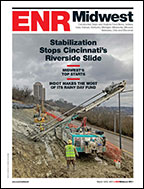
The American Institute of Steel Construction continues to drill deep into the steel sector's supply chain to improve both e-commerce and steel deliveries to fabricators. AISC's ongoing e-procurement initiative, called steelXML, has even inspired an independent study that is researching the need for a digital tool that would use steelXML's e-purchasing data to help designers create structures that are more efficient, economical and sustainable.
"We need to advance e-procurement," said Matthew J. Gomez, national manager for construction solutions with supplier Gerdau and chairman of the AISC steelXML technical group, at AISC's 2015 North American Steel Construction Conference, held on March 25-28 in Nashville.
AISC's steelXML effort is one of its "BIMsteel" e-commerce initiatives. SteelXML is short for the "Common XML Schema for the Electronic Procurement of Structural Steel." For the project, AISC is collaborating with the Digital Building Laboratory at the Georgia Institute of Technology to develop the steelXML schema, a standard specification that electronically maps transaction and communication workflows. Information moves between structural-steel buyers—fabricators and steel service centers—and suppliers, including service centers and steel mills.
The goal is to eliminate data-entry rework. Fabricators will no longer have to order steel by fax or an emailed PDF attachment—both of which require multiple manual data entries and updates.
Suppliers also are drowning in paperwork. In one shop, 40% to 60% of the sales force's time is spent on data entry, said one supplier at the conference, which drew a record 4,582 registrants.
The specification eventually will automatically update 10 bidirectional data exchanges—requests and responses—through 17 XML schemas. The 10 exchanges are availability inquiries, price quotes, purchase orders, order status queries, advanced shipment notices, material test reports, invoices, payments, sustainability data and bills of lading.
To date, schemas for availability, quotes, purchase orders and advanced shipment notices have been released. The rest will follow this spring, says AISC.
Meanwhile, the steelXML project has inspired a one-year study by Stanford University's Center for Integrated Facility Engineering. The work, funded by CIFE and Autodesk Inc., is looking at whether a commercial product that leverages e-procurement transactions would be useful to designers.
The goal of the research is to verify designers' interest in and need for access to steelXML transactional data "to make better design decisions," says Michael Gustafson, Autodesk's industry strategy manager for structural engineering.
The project, which will be done by January, is developing technology that would allow practitioners to visualize the relative cost, availability and embodied carbon of individual steel members in the context of a building information model.
The research team—led by Martin Fischer, CIFE's director, with Forest Flager, a CIFE research associate—is also developing multi-objective optimization algorithms to help designers quantitatively evaluate trade-offs between design objectives—for example, cost versus availability and cost versus carbon content—and to identify structural design solutions that best meet project objectives.
CIFE will compare the effectiveness of the tool through design charrettes in September and November. For each, two groups will be given the same design problem, but only one will have access to the new tool. The CIFE team will measure each group's design process in terms of the time required to generate and analyze design alternatives, number of alternatives analyzed and more. Charrette participants will provide feedback on the tool.
For AISC's steelXML, an issue is that, to date, only three steel suppliers—which have to code an XML translator into their software for fabricators to use steelXML—are able to accept a steelXML file: Gerdau, Infra-Metals and Nucor Corp. "The mission of developing the schema has been met," said Gomez. "Now, we have to see industry implementation."



Post a comment to this article
Report Abusive Comment